Welcome to our Chinese Noodles and Wrappers ingredients page!
There’s a broad variety of fresh/dried noodles and dumpling, wonton, spring roll, and egg roll wrappers used in Chinese cooking. We’ll try to cover the most common ingredients here. You’ll see that we use a variety of brands and types in our recipes. We’ve also marked the ones that are gluten-free!
If you’re looking for more information on other Chinese Ingredients, go to our main Chinese Ingredients Glossary page to review various categories. As always, let us know in the comments if you don’t see something you’re looking for, and we’ll do our best to add it!
Fresh white noodles
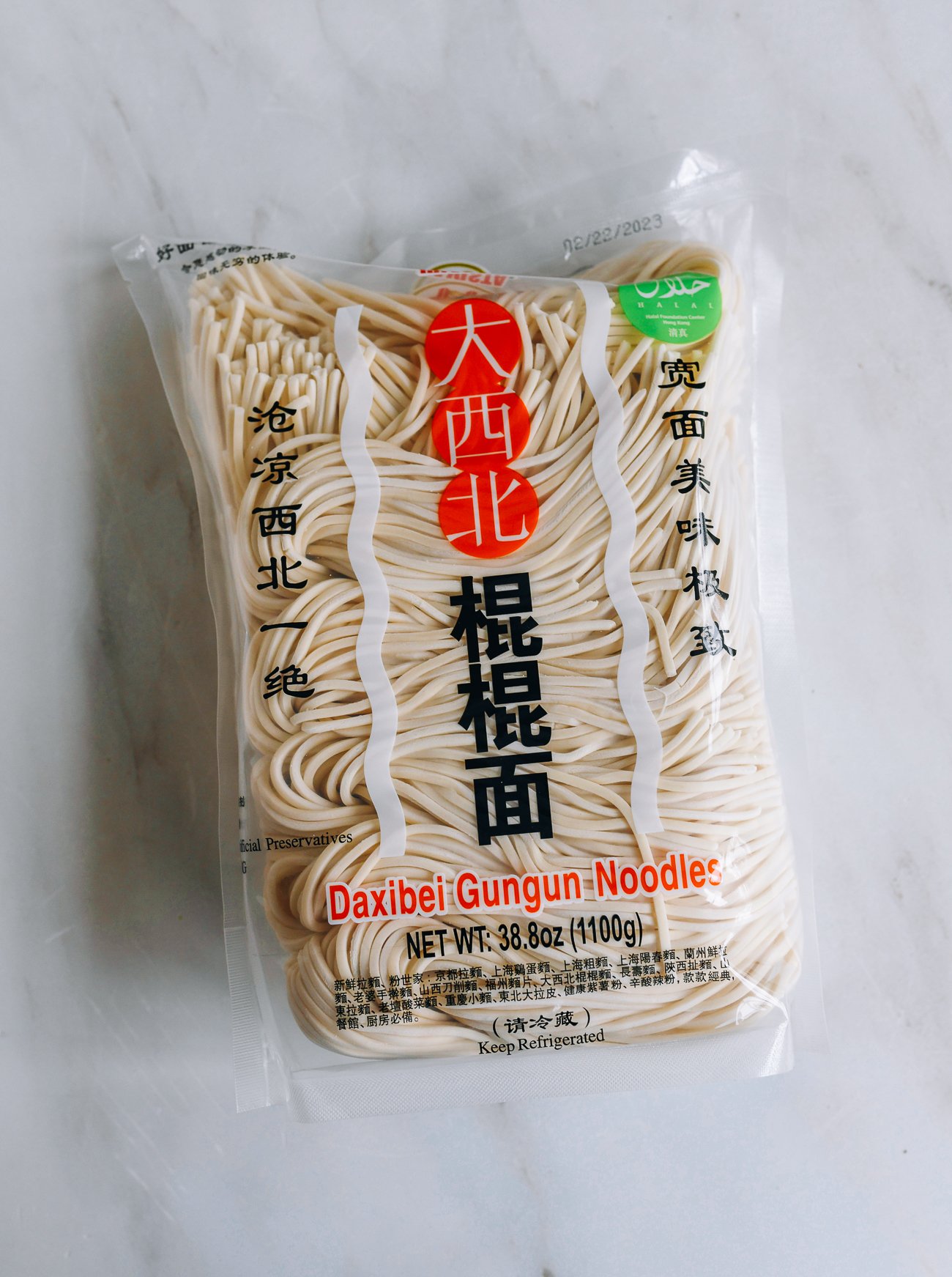
These simple white noodles are usually made with just water and wheat flour and come in a wide range of thicknesses. They’re ideal for noodle soups, sauced noodle dishes like dan dan noodles, or for steaming in recipes like our Bian Dou Men Mian. After boiling until al dente, you can rinse with warm water to prevent sticking (an optional step), drain, and continue with your recipe! Find them in both refrigerated and freezer sections of Chinese markets. You can also make our handmade Chinese noodles.
Dried White Noodles
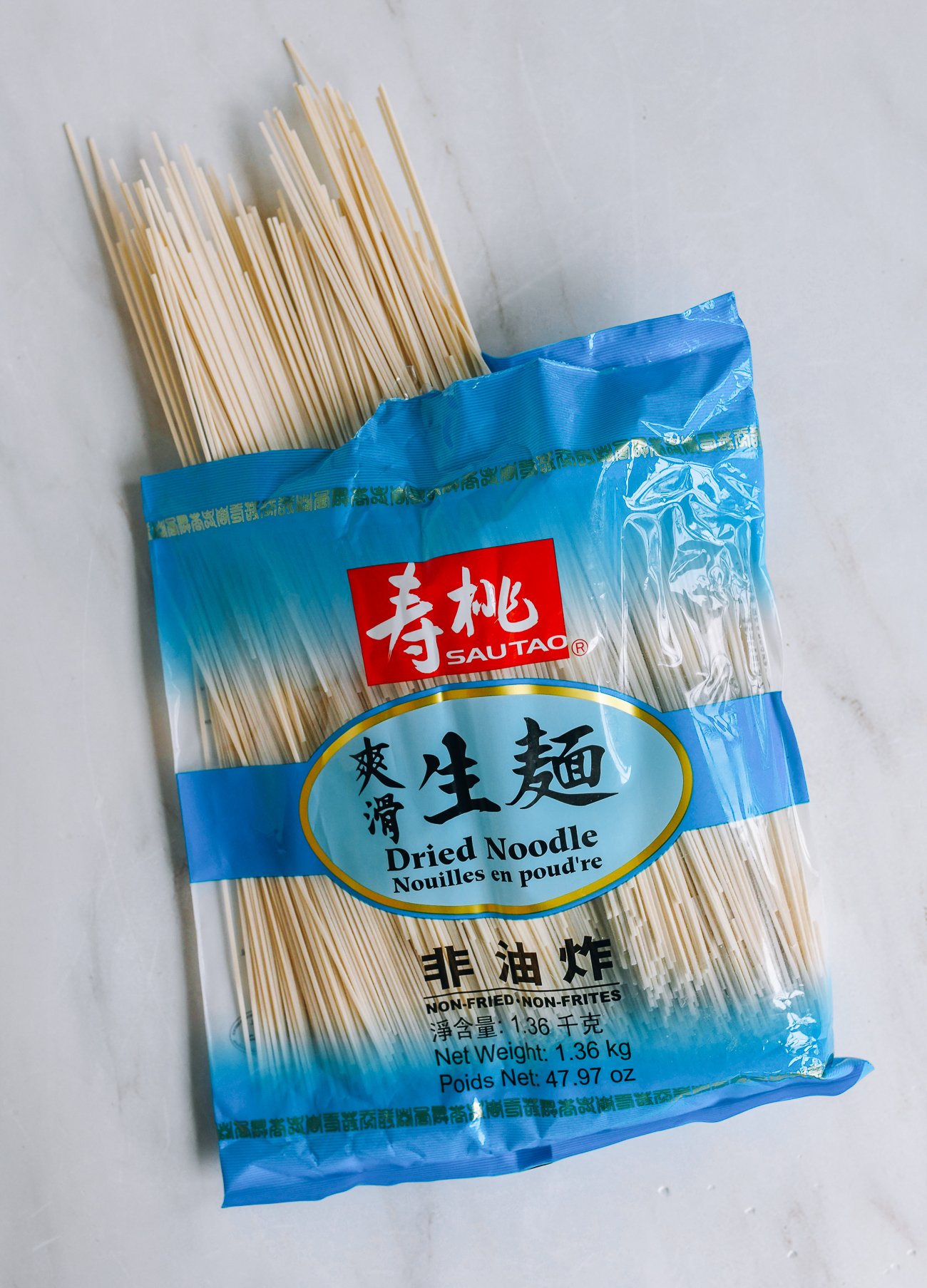
Like fresh white noodles, dried white noodles also come in a variety of thicknesses. Pick what you like! We generally prefer thinner dried noodles for use in noodle soups. They’re a convenient option, as they last a long time in your pantry—just like dried pasta. If you can’t find fresh wheat noodles, you can substitute dried in most cases. You’ll find Chinese, Korean, and Japanese brands—any is generally fine, as they are all made in similar processes. Try a few brands to see what you like best.
Shanghai-style thick noodles/udon noodles
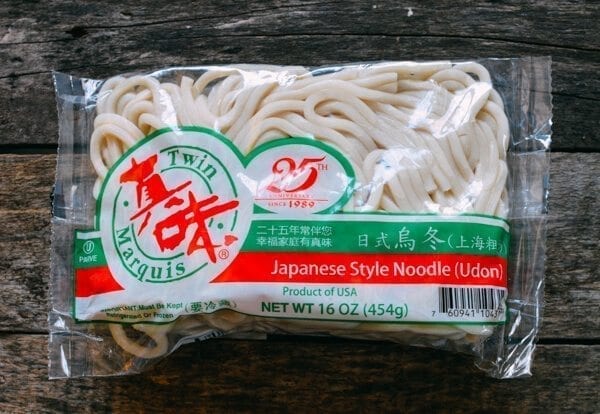
While thick Shanghai-style noodles and Udon noodles are technically different, they are a similar thickness, and you’ll often see the word “udon” on Chinese labeling for this type of noodle (see left).
While you may see Japanese udon sold dried, fresh, or frozen, this style of Chinese noodle is usually sold fresh in the refrigerated section. Use either to make recipes like our Shanghai Fried Noodles, our Yaki Udon, or Chicken & Mushroom Udon Noodle Soup.
Knife-Sliced ribbon noodles

These crowd-pleasing noodles are wide with ruffled edges—great for holding onto sauce. They’re called dāoxiāomiàn (刀 削面) or literally, knife cut noodles. The packaged version is a reproduction of noodles that are hand-sliced from a large mound of dough right into a pot of boiling water. For those of us who don’t have a personal noodle slicing master hanging around, these will have to do.
Fresh Hong-kong-style Noodles for Pan-frying
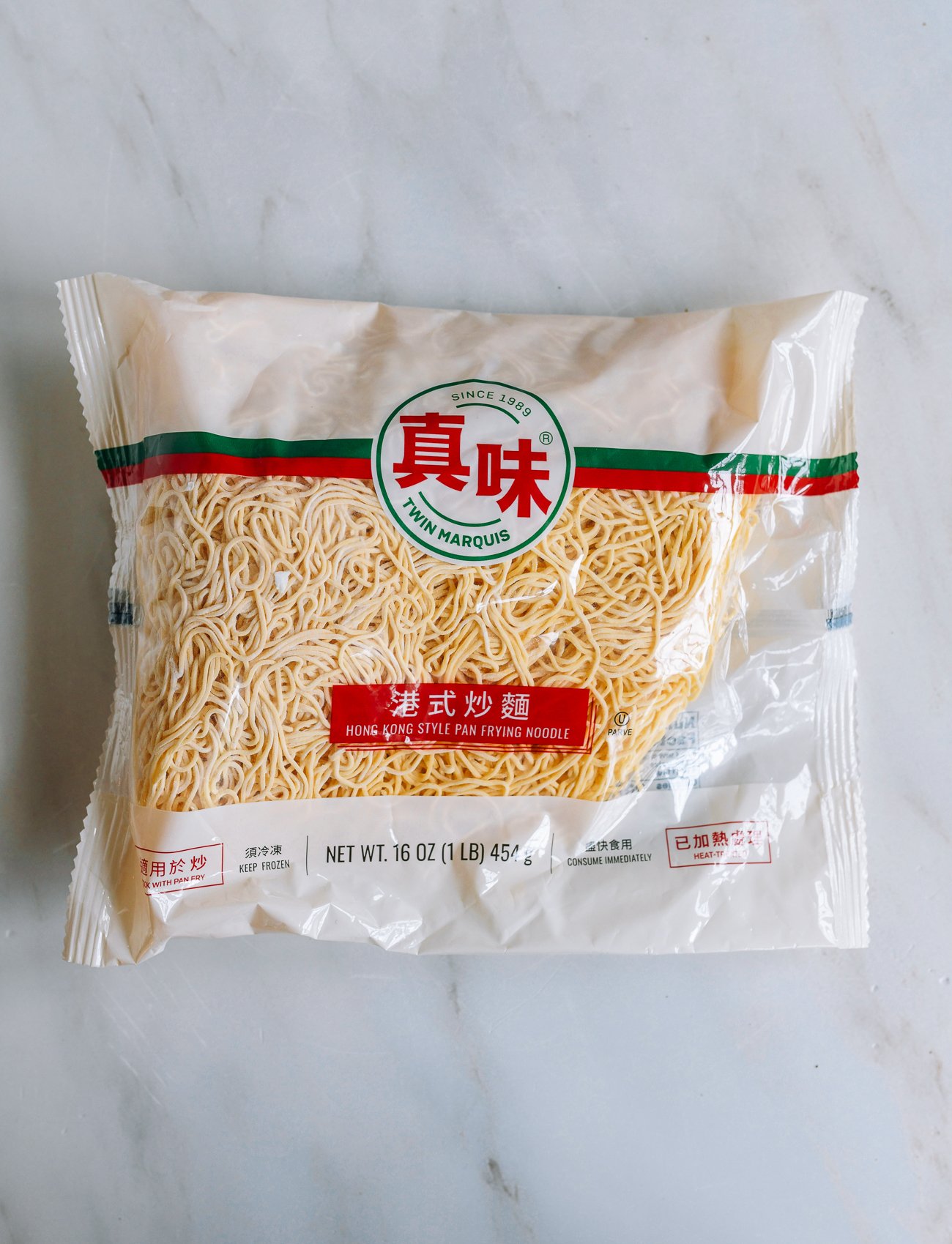
Also known quite generally as “chow mein” noodles, these thin, yellow noodles are made for pan-frying in oil for such dishes as our Shrimp Chow Mein and Cantonese Soy Sauce Pan-fried Noodles. You can find them in the refrigerated section of the Chinese grocery. They must be cooked in boiling water for about 1 minute, rinsed, and drained before pan-frying. Avoid overcooking them, or they won’t crisp up properly. Also don’t confuse them with wonton noodles, which look similar but are used in soup.
Dried Hong-kong-style Noodles for Pan-frying
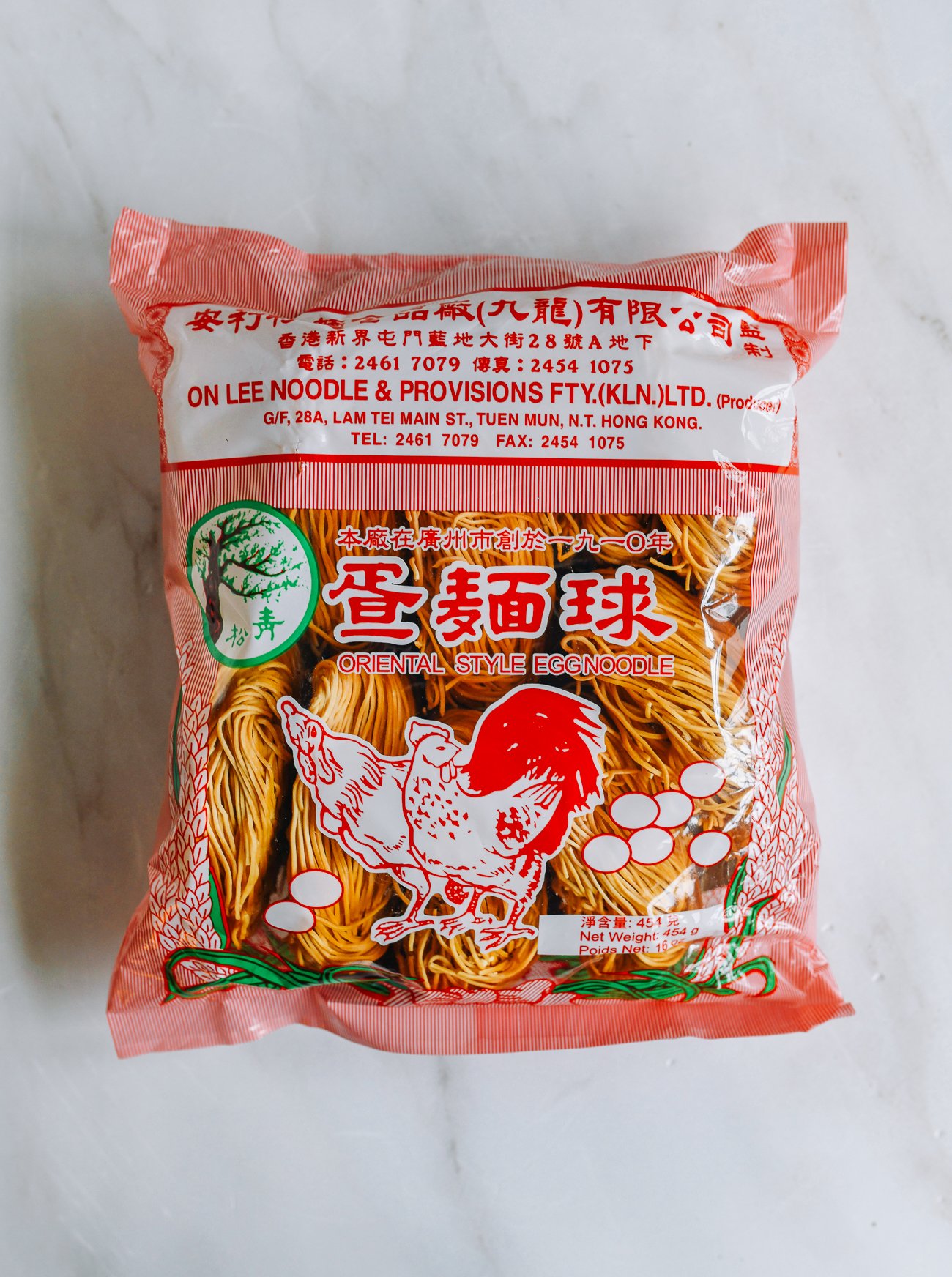
You can also find the dried version of the above Hong-Kong-style pan-fried noodles, which are a great addition to your pantry. Some are made with shrimp to add extra fragrance and flavor to the noodles, while others are just plain egg noodles. Just cook for a few minutes in boiling water (follow package instructions), rinse in cold water, drain, and you’re ready to throw them into any of our pan-fried noodle dishes, like Pan Fried Noodles with Chicken or Vegetable Chow Mein.
Wonton Noodles
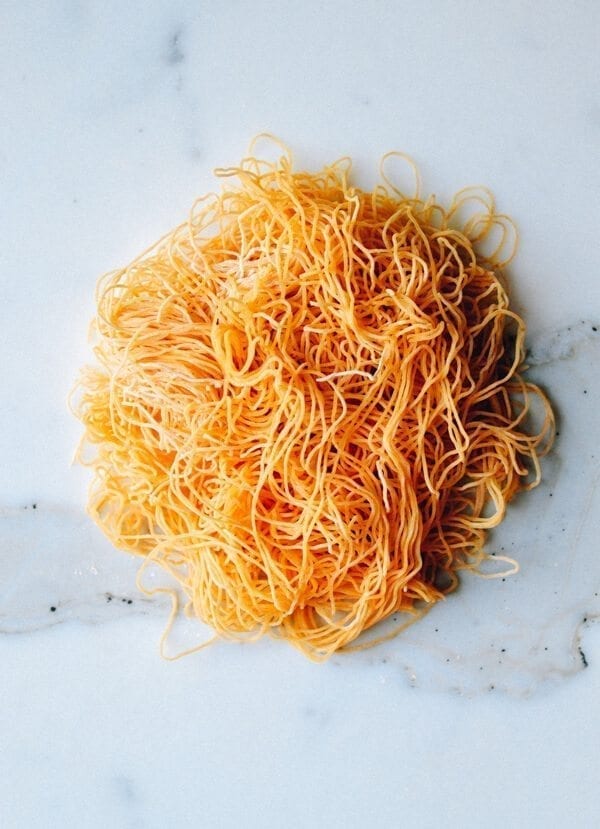
These noodles look very similar to Hong-Kong-style pan-fried noodles. To make things more confusing, you’ll sometimes see “Hong Kong” also on the label for these noodles, which are used in Cantonese-style Wonton Noodle Soup—a classic combination of noodles and wontons in broth. They’re chewier and more elastic than their pan-fried cousins, as they are made with more alkaline solution (jiǎn shuǐ – 枧水), which gives them their deep yellow color and bouncy texture. They also come in a wider version (see below for both, side by side).
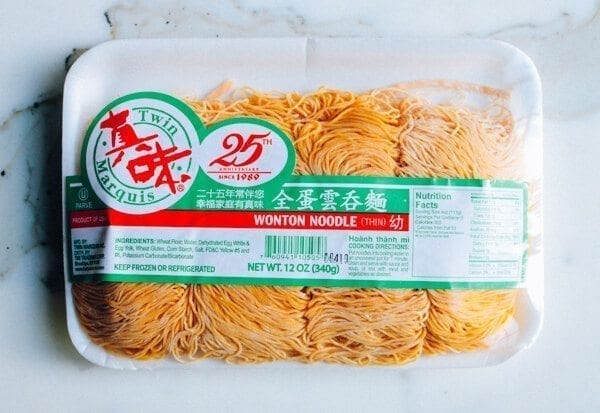
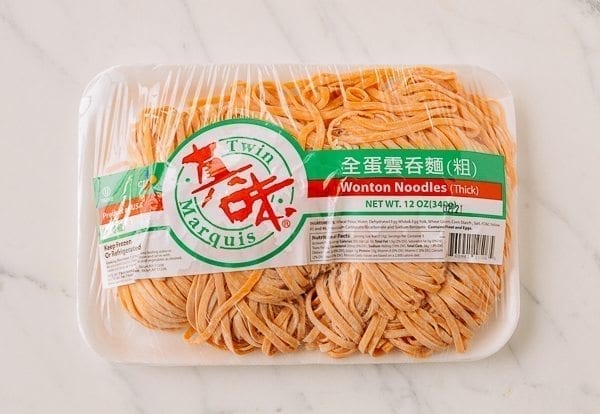
Long Life Noodles (Yi Mein)
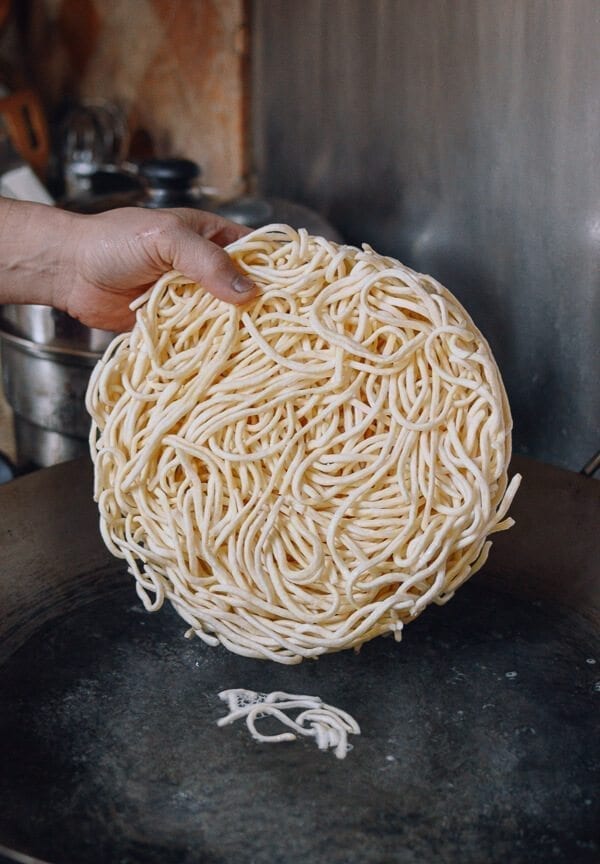
Long Life Noodles (yī miàn, 伊面), or yi mein, symbolize longevity. While technically, any type of long noodle symbolizes longevity, Yi Mein (also known as e-fu noodles) are a festive, traditional addition to Cantonese-style banquet dinners. They have a spongy, chewy texture, since they are fried before drying. They can be expensive, but it’s worth making Long Life Noodles at home. They are quite delicious, though they can sometimes get overcooked at banquet dinners—since the chefs have to cook them in such large quantities.
Some believe that Yi Mein were named after a chef named Yi, who deep-fried egg noodles in oil before cooking them again in boiling water to not only give them a chewy texture, but also to make them harder to break. Since then, they took on the symbolism of longevity, because of their resiliency. The alternative name, e-fu noodles, may refer to “the house of Yi,” which supports this chef story!
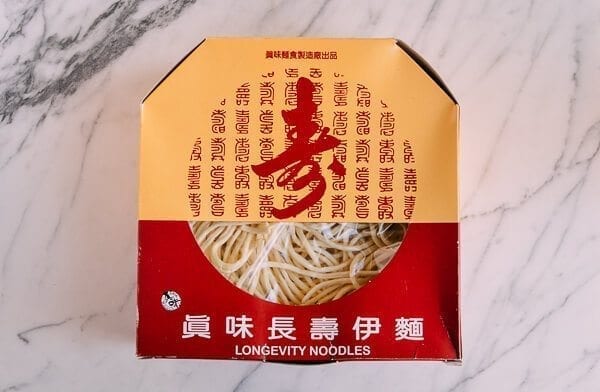
Lo Mein Noodles
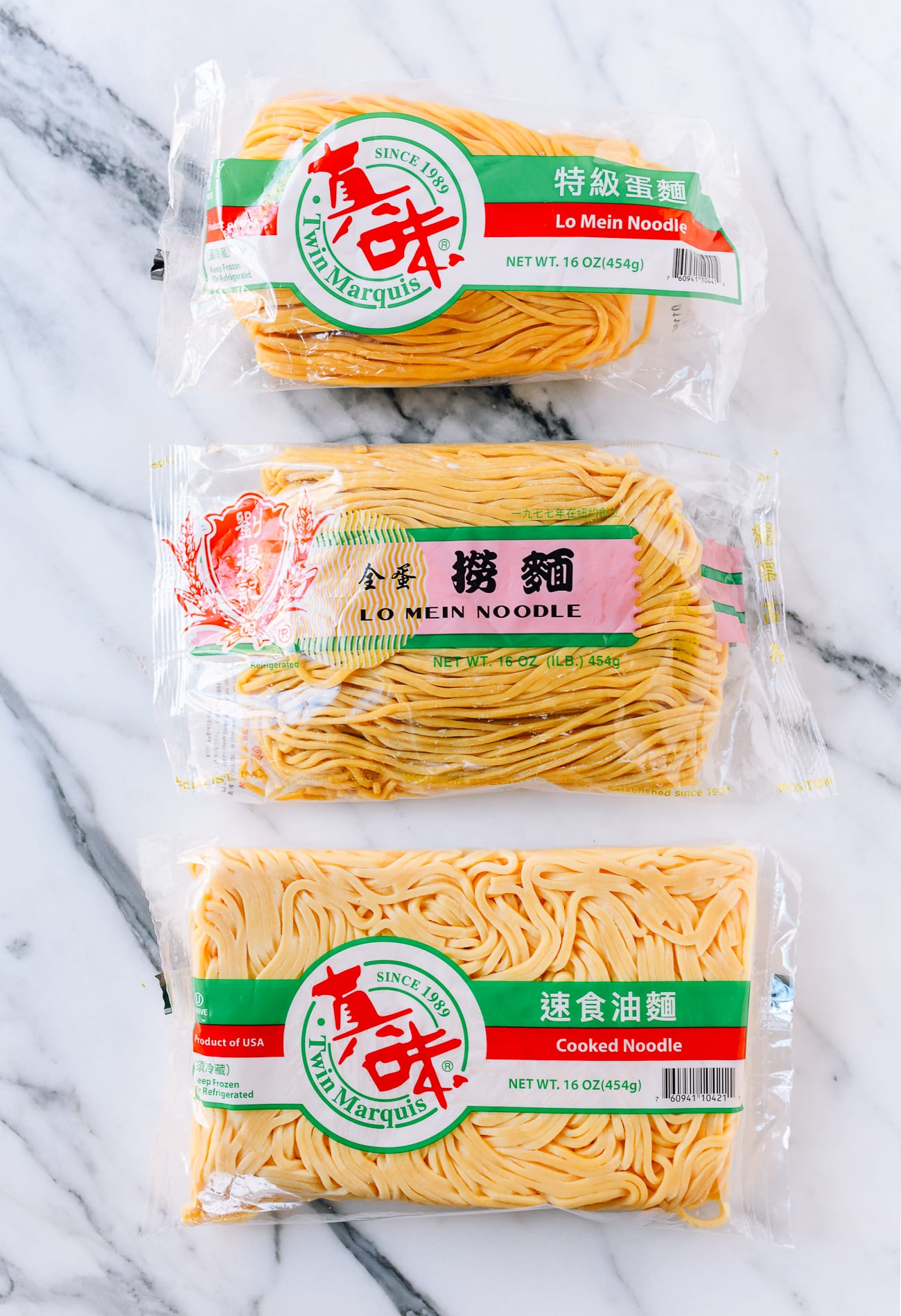
You’ll find two types of lo mein noodles: uncooked and cooked (AKA “oil noodles”). Both can be found in the refrigerated section near the other fresh noodles. Don’t mistake raw noodles for the cooked ones, or you’ll have a starchy, sticky mess and wonder where you went wrong! Uncooked lo mein noodles must be boiled in water and rinsed before using. Use these noodles to make any of our lo mein recipes, like Chicken Lo Mein or Beef Lo Mein. You can also use them in noodle dishes found in Singapore and Malaysia, like Hokkien Mee and Laksa.
Fresh Wide Egg Noodles
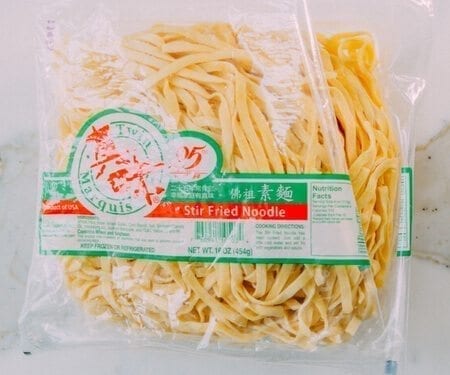
These wide noodles are designed for stir-frying. You can also use them to make deep-fried crispy noodles, like they used to serve in East Coast Chinese restaurants with sweet duck sauce, or on top of American Chicken Chow Mein. Find them in the refrigerated section near the other fresh noodles.
Rice vermicelli
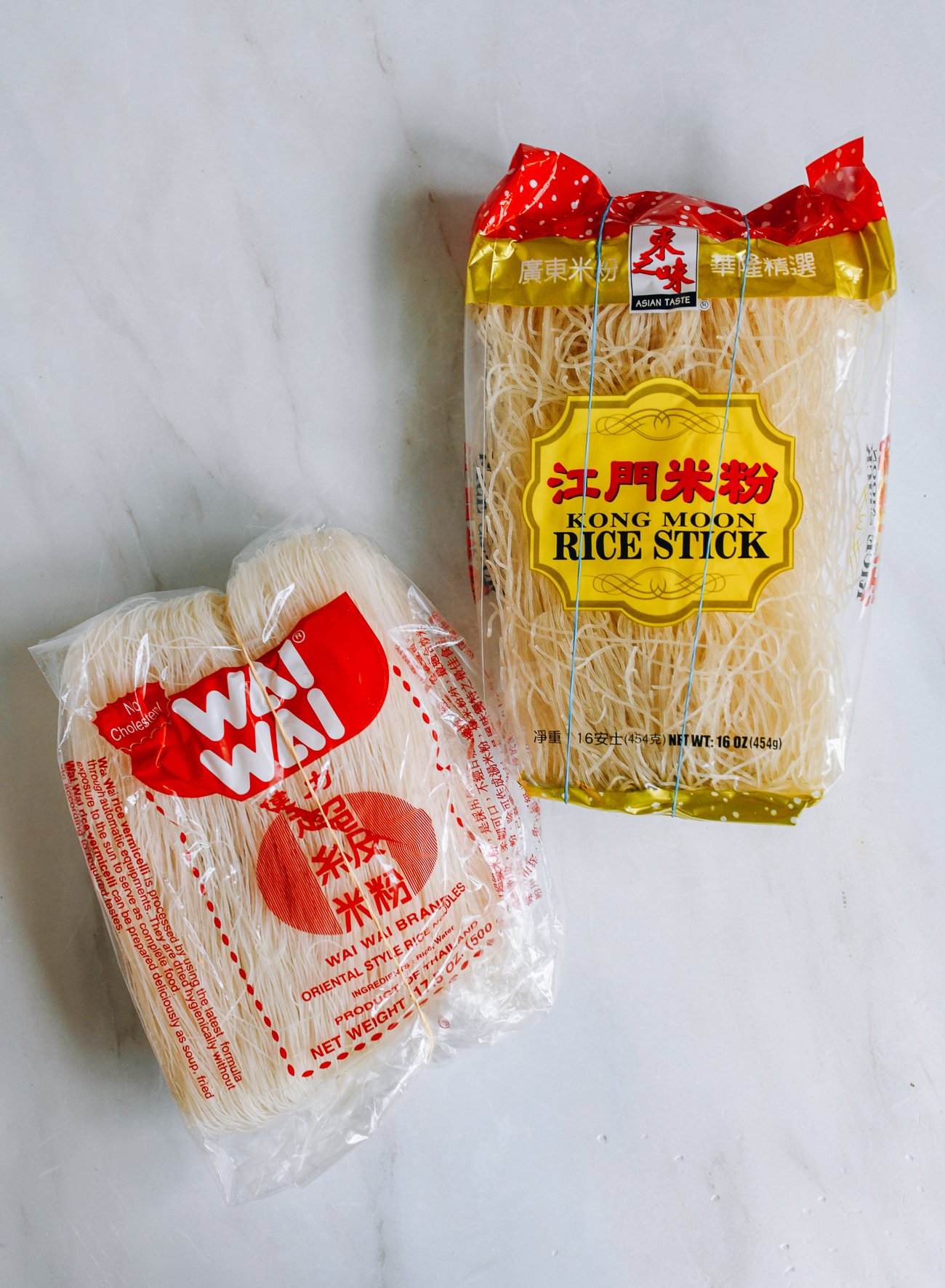
These rice noodles, sometimes labeled, “rice sticks” and called “mei fun” or “mai fun,” are thin, brittle, and white. Soak them in lukewarm water for ten minutes before using in noodle stir-fries. They come in rectangular blocks. Store unused noodles in a plastic bag in a cool, dry place. These noodles are used in Singapore Mei Fun, Vegetable Singapore Noodles, and Judy’s Chicken Mei Fun. You also can’t go wrong with delicious Xiamen Mei Fun! Sarah also calls for them in her Coconut Curry Noodle Soup. *Gluten-free.*
Jiangxi rice noodle (Mi Xian)
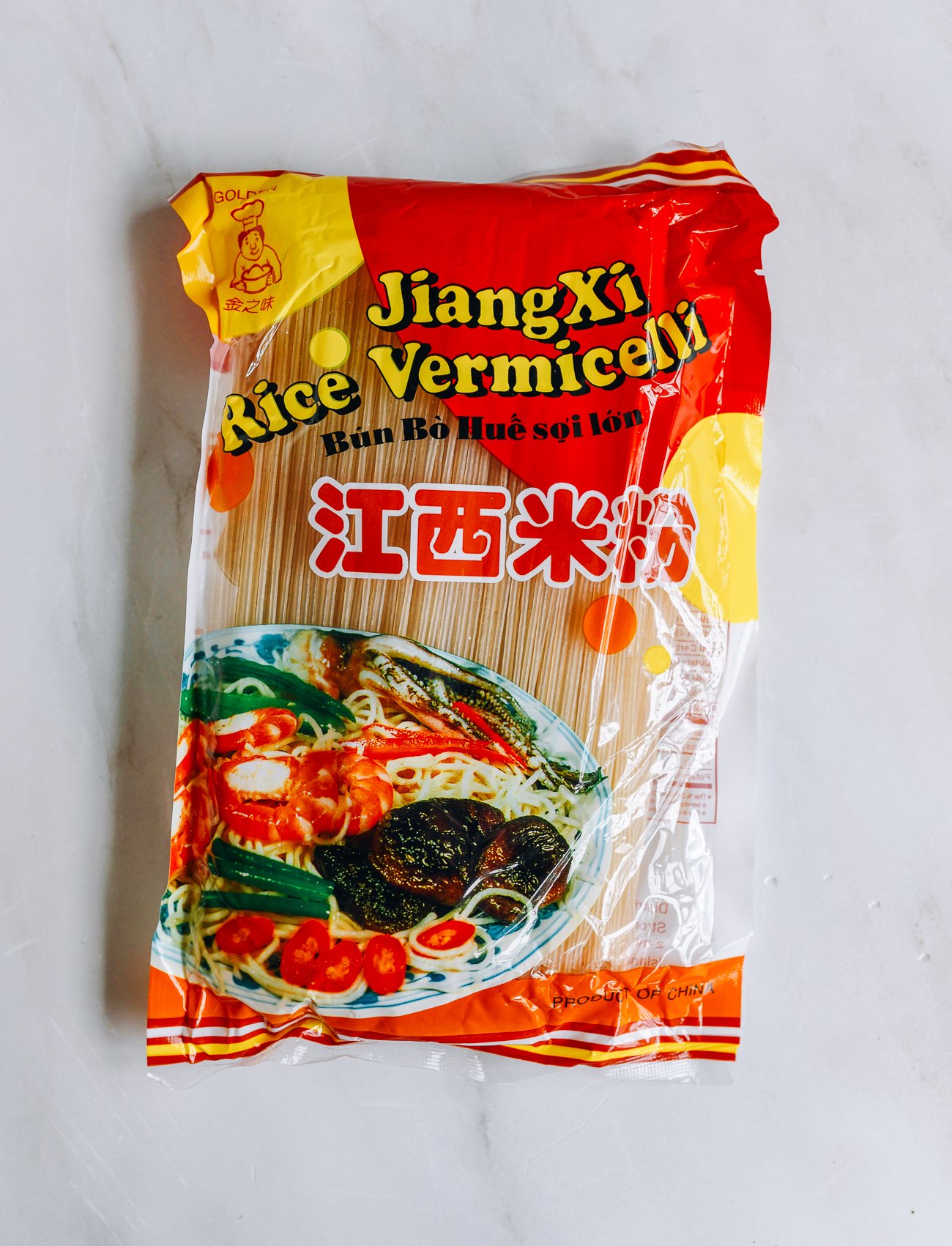
Jiāngxī mǐxiàn (江西米线) are a type of rice noodles eaten all over southwestern China. They come in different thicknesses, sometimes with different names on the labels, like “rice stick” and “rice vermicelli,” but in general, they have a thickness resembling spaghetti. They are also the same noodles you might find in Vietnamese Bún Bò Huế. When using dried rice noodles, follow the instructions on the package before adding to noodle soups like Judy’s Yunnan Rice Noodle Soup.
Sometimes, you can also find them fresh in the refrigerated section, though we actually prefer the dried kind. *Gluten-free.*
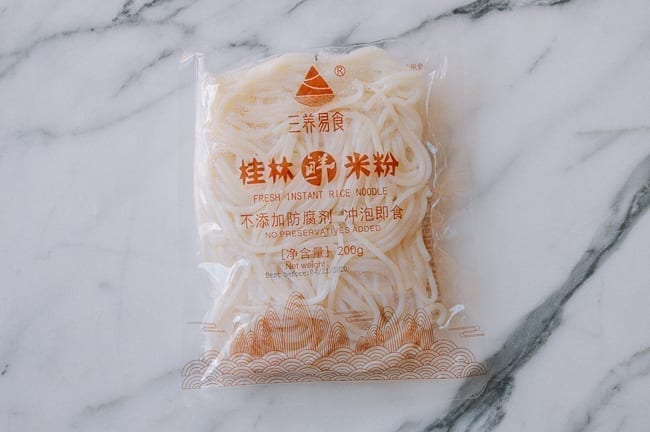
Rice Noodles for Pad Thai Or Pho
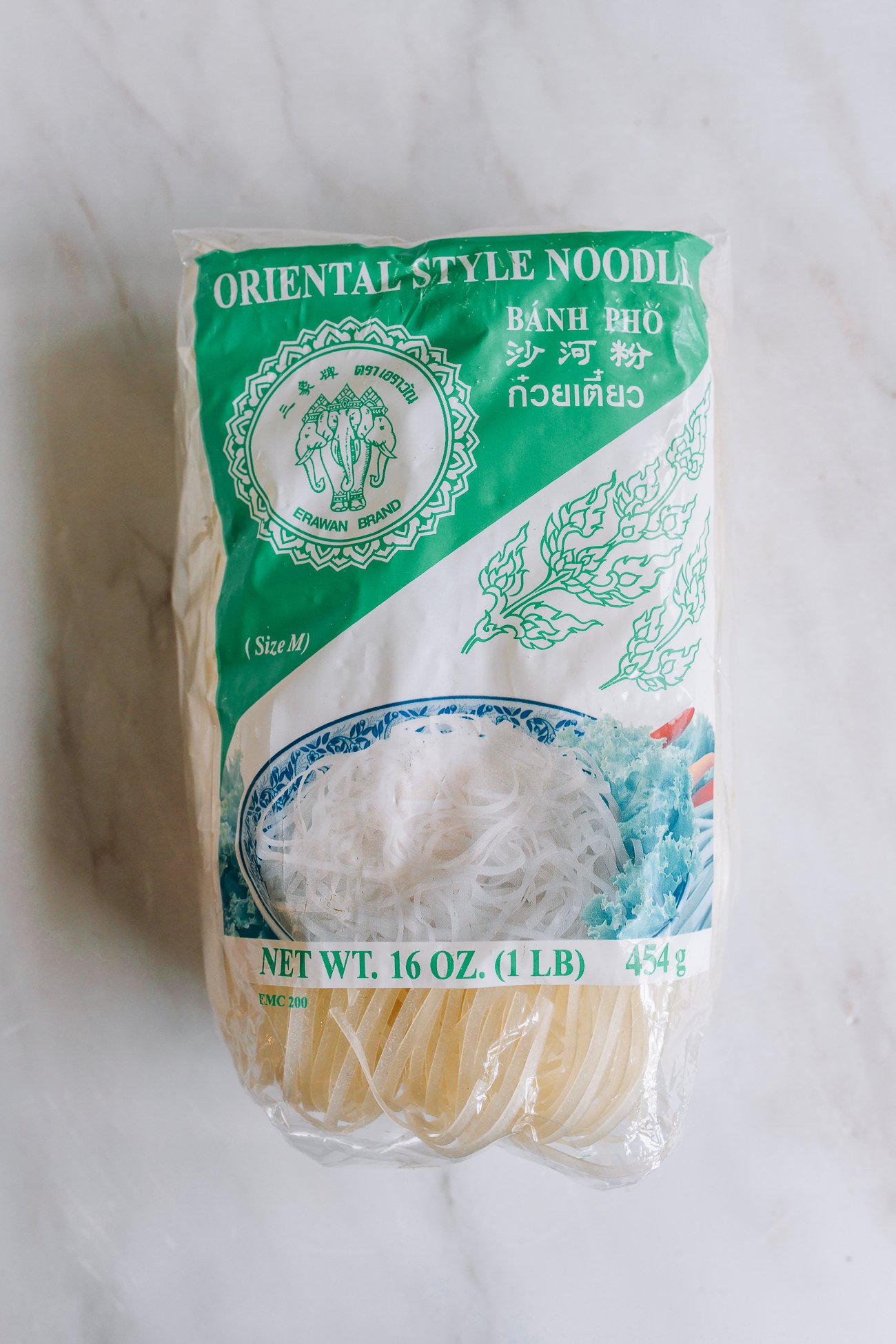
These rice noodles are thicker than vermicelli, but thinner than wide rice noodles. They can be stir-fried for dishes like pad Thai or used in noodle soups like Vietnamese Pho. Find them in the dried noodle aisle of Chinese or Southeast Asian markets. To prepare them, you can follow the package instructions, but be sure to check them during cooking to make sure that you stop cooking the noodles once they’re al dente. Then drain the noodles and rinse them in cold water to rinse off excess starch and stop the cooking process. *Gluten-free.*
Wide Rice Noodles
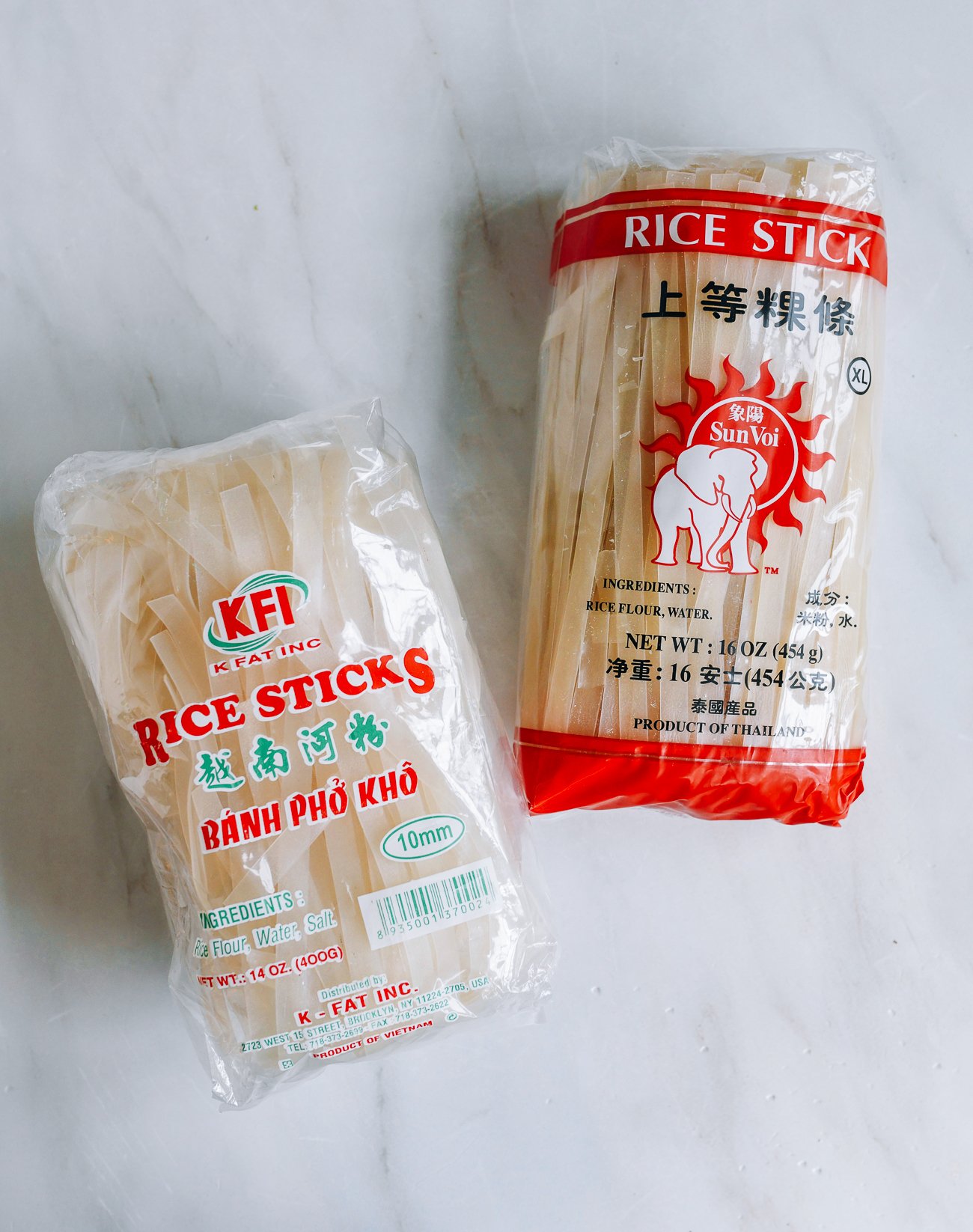
Wide rice noodles can be boiled for soup or stir-fried. There are many brands out on the market. Finding your preferred brand comes down to trial and error and personal preference. We have used several brands from our Chinese market, and many have worked great. We actually sometimes prefer dried rice noodles for stir-fries like Beef Chow Fun or Drunken Noodles (Pad Kee Mao) instead of fresh, for more consistent results (the quality of fresh noodles varies widely). *Gluten-free.*
Ho Fun (Fresh Wide Rice Noodles)
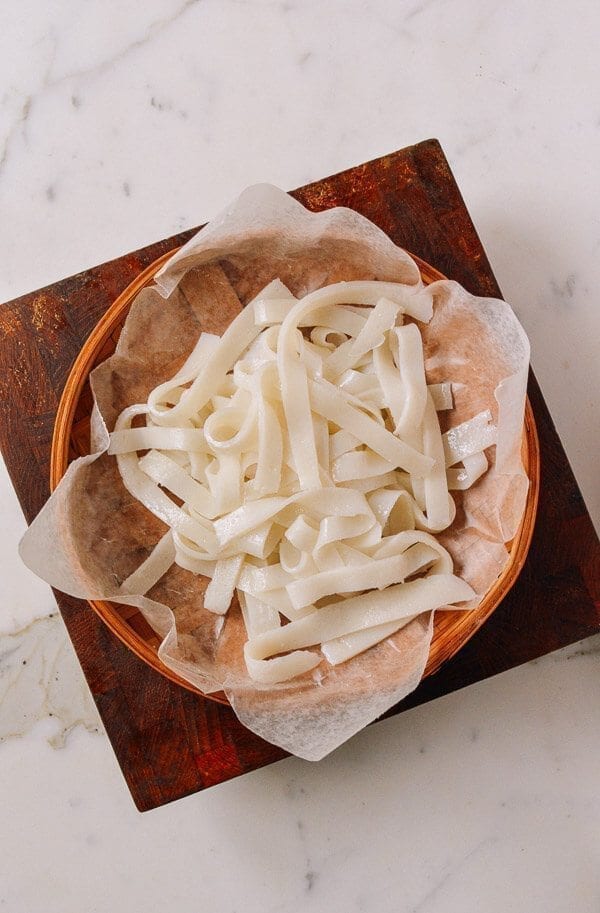
You may see fresh rice noodles, known as hé fěn (河粉) in Mandarin or ho fun in Cantonese, in Chinese markets, but they’re hard to find. Our local store gets them fresh on the weekends, sold in long sheets that have been steamed, lightly oiled, and, folded. At their best, they’re flexible and slippery—used in soups and stir-fries. That said, some refrigerated brands can be very stiff and stuck together, making them difficult to stir-fry. Soak them in hot water to loosen them. Make your own homemade rice noodles, and try our Beef Chow Fun or Vegetable Chow Fun! *Gluten-free.*
Mung Bean Vermicelli
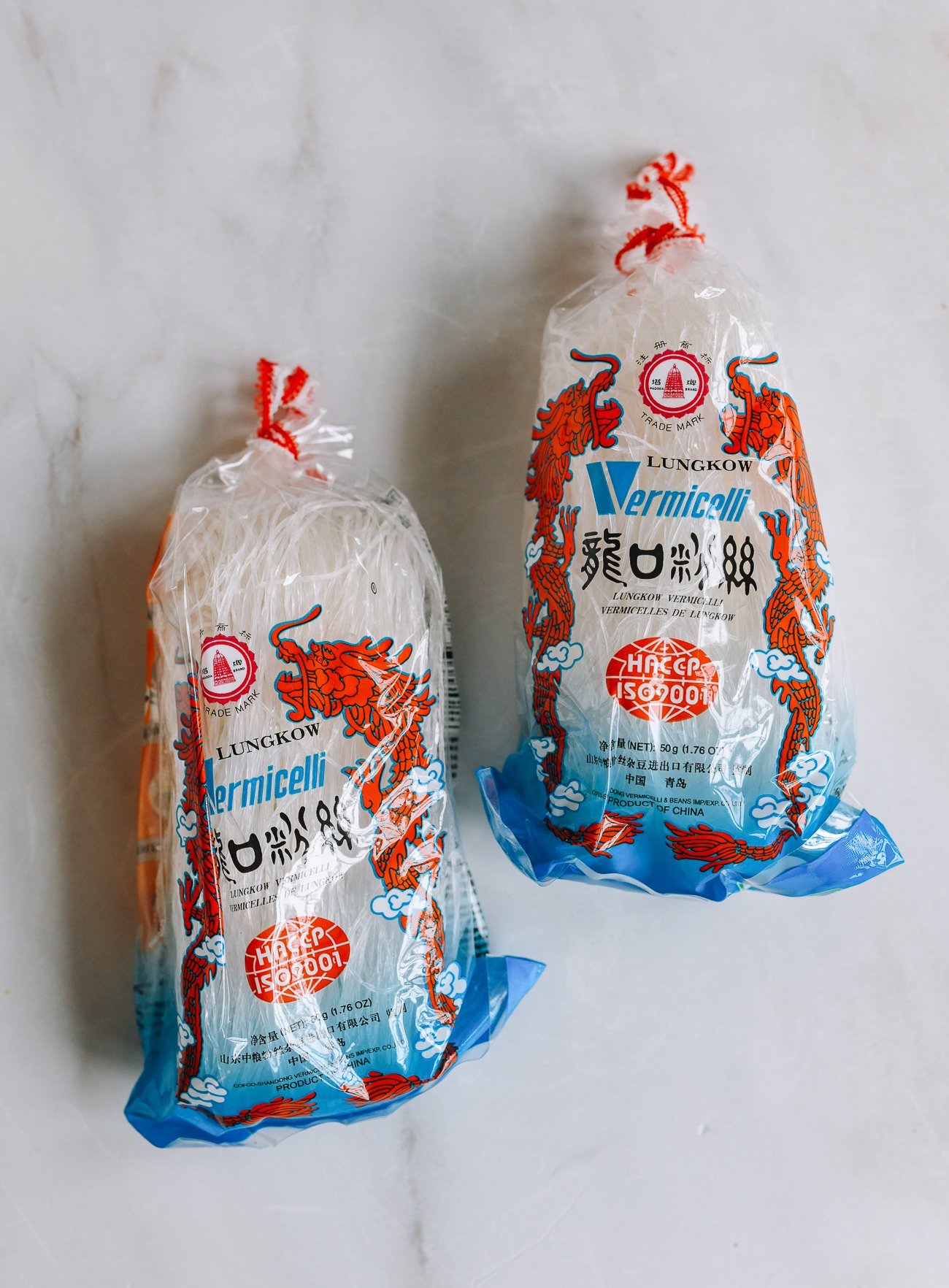
These thin noodles are known as fěnsī (粉丝) in Mandarin or fun see in Cantonese. Don’t confuse them with rice vermicelli, which look similar. They’re made from mung beans and must be soaked for about 10 minutes before cooking (unless you’re adding them to a soup, in which case they can be added directly). When cooked, they’re translucent. Find them in small bunches tied with twine in Chinese grocery stores. These noodles are delicious little sponges, soaking up sauces and flavors. *Gluten-free.*
Sweet Potato Starch noodles
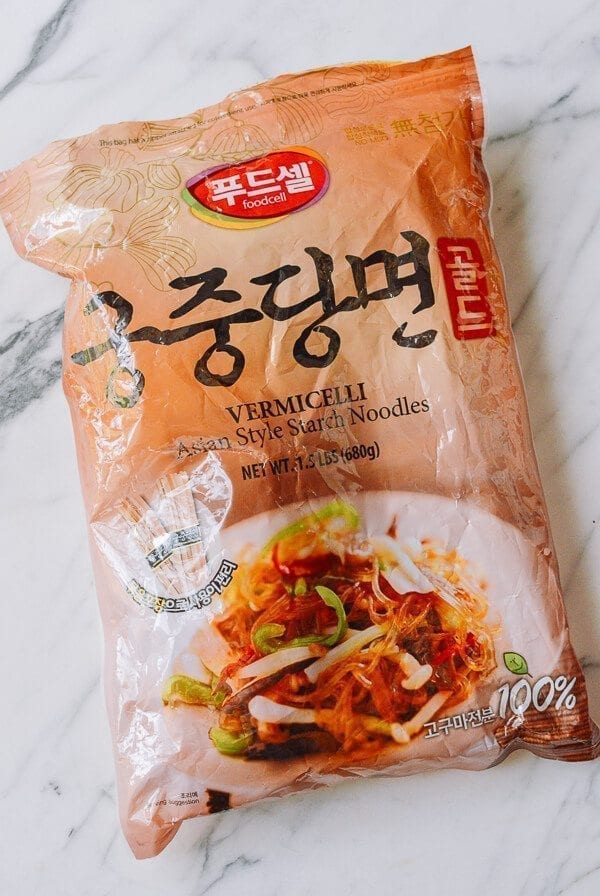
These are another type of glass or cellophane noodle, made with sweet potato starch. They’re grey in color (rather than white) and thicker than mung bean vermicelli, though their texture is similar. After cooking, they’re about the thickness of spaghetti. We usually buy Korean brands, which are the most widely available. Use them in our Japchae recipe, a Korean noodle stir-fry. You can also use them in our Northern Sour Cabbage Stew with Pork Belly. If you can’t find them, you can usually substitute mung bean noodles. *Gluten-free.*
Dried Ramen noodles
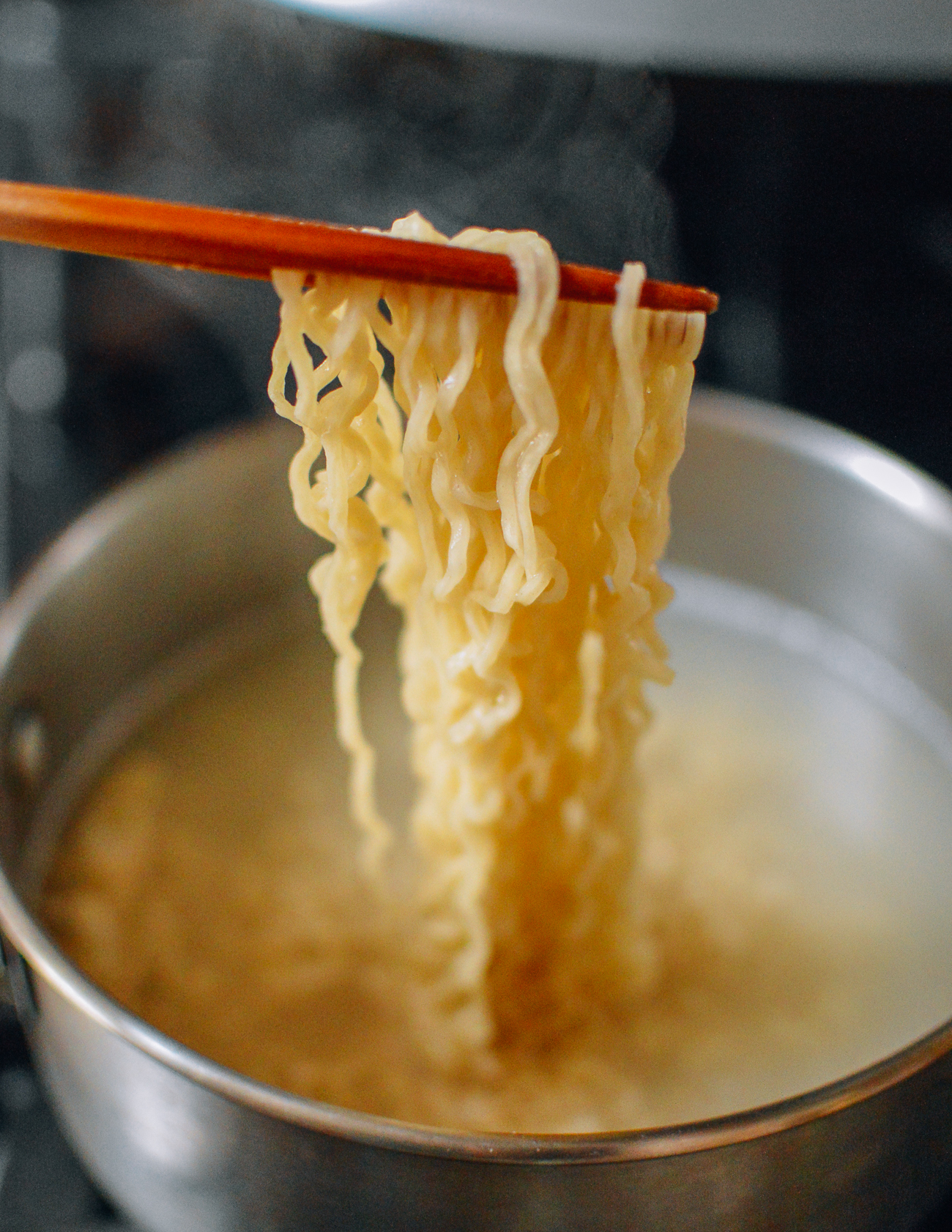
We all know what these are—packets of dried, instant ramen noodles that make a cheap, easy snack or meal. We’ve dolled up instant ramen in recipes like Pho Ramen, Curry Ramen, Kimchi Ramen, and Laksa Instant Ramen. You can also find these dried wavy noodles in Asian markets—gasp!—without the flavor packets! You’ll also find imported brands of instant noodle from across Asia, with a wider variety of flavors! If you have ramen noodles around and don’t want soup, you must try our Stir-Fried Vegetable Ramen.
Fresh Ramen noodles
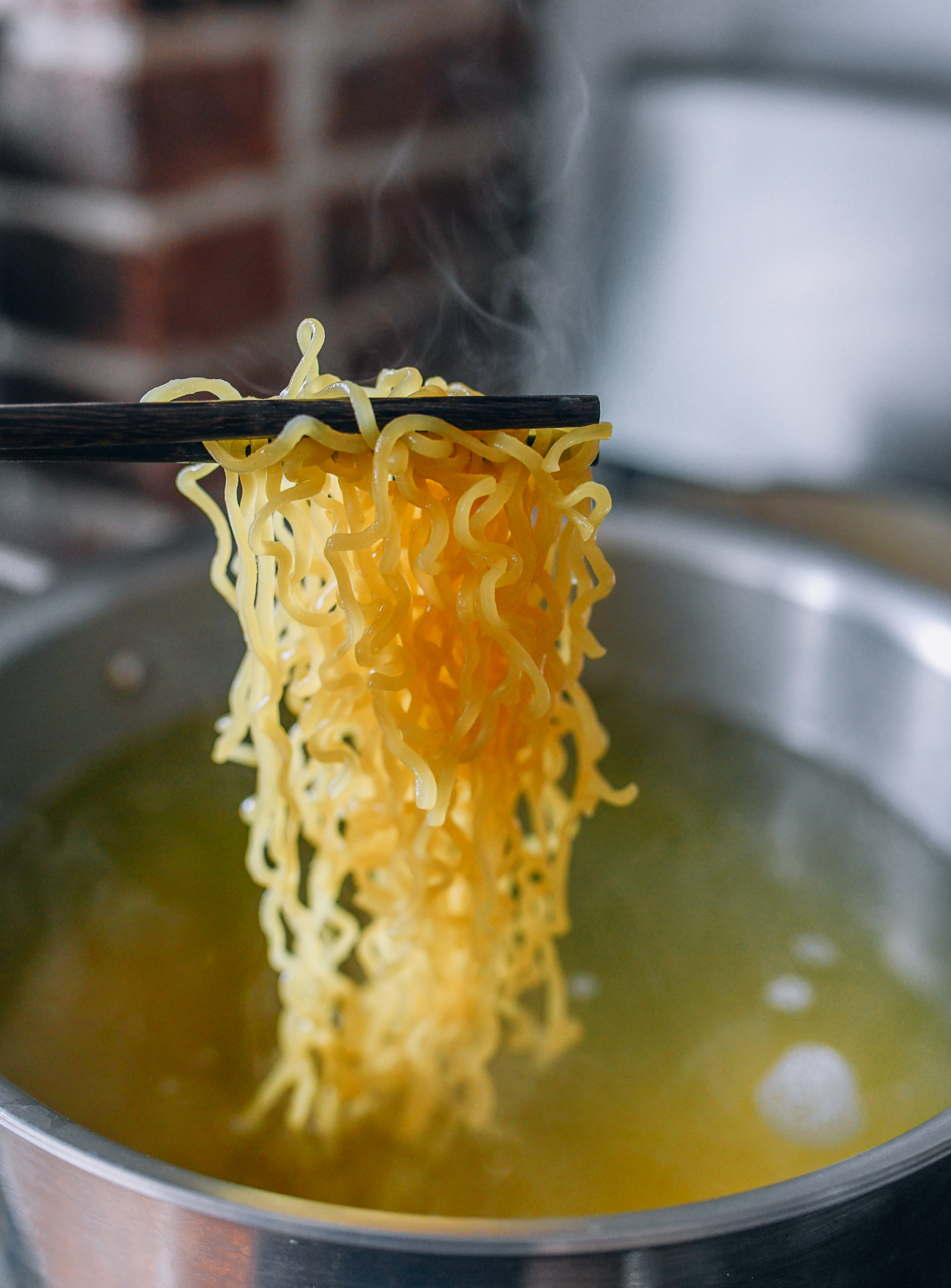
Fresh ramen noodles are also available at Asian grocery stores, with a much better taste and texture than dried. We particularly like fresh noodles from Sun Noodle company. Another important but lesser-known fact is that ramen noodles are a type of alkaline noodle, made with an alkaline solution like potassium carbonate that gives them their bouncy texture and pale yellow color. You may see fresh ramen noodles that come with flavor packets for soup. Try our Vegan Ramen and spicy Tan Tan Ramen.
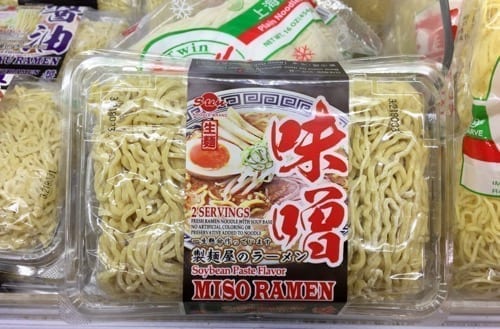
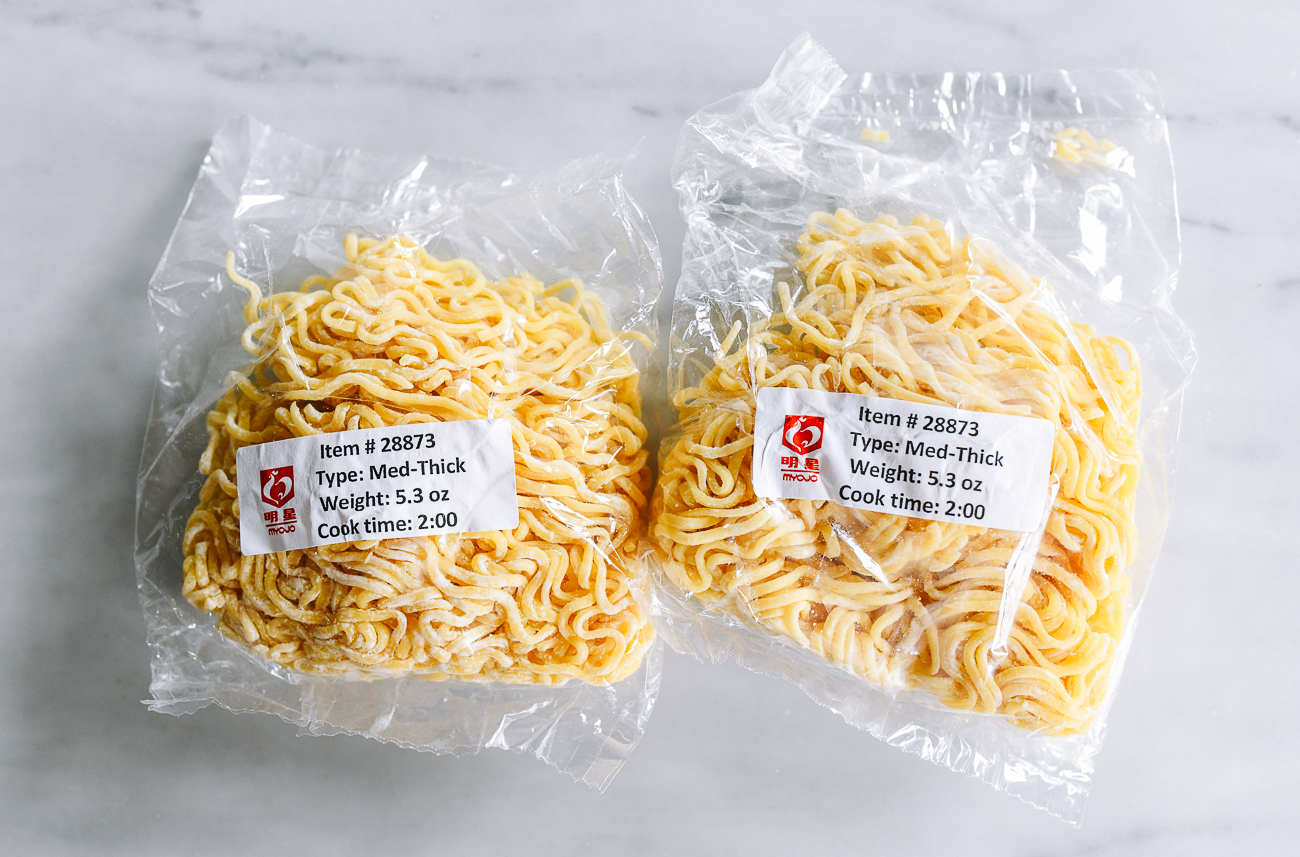
Yakisoba noodles
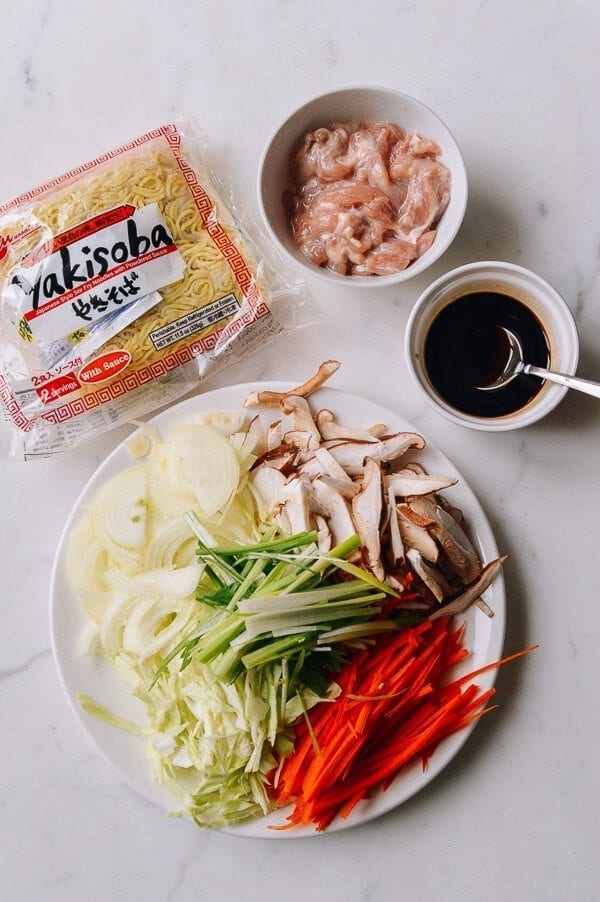
Yakisoba, or literally “fried noodles” in Japanese, are a popular stir-fried noodle dish. Its preparation is similar to a Chinese lo mein dish. Yakisoba noodles are generally made from wheat flour, with a slightly wavy appearance that may cause you to confuse them with ramen noodles, which are used in soup. Just look for the term “yakisoba” on the package. You’ll find them in the refrigerated noodle section of Asian markets. We use these noodles in our own Chicken Yakisoba and Vegetable Yakisoba recipes, courtesy of Sarah!
Rice Cakes
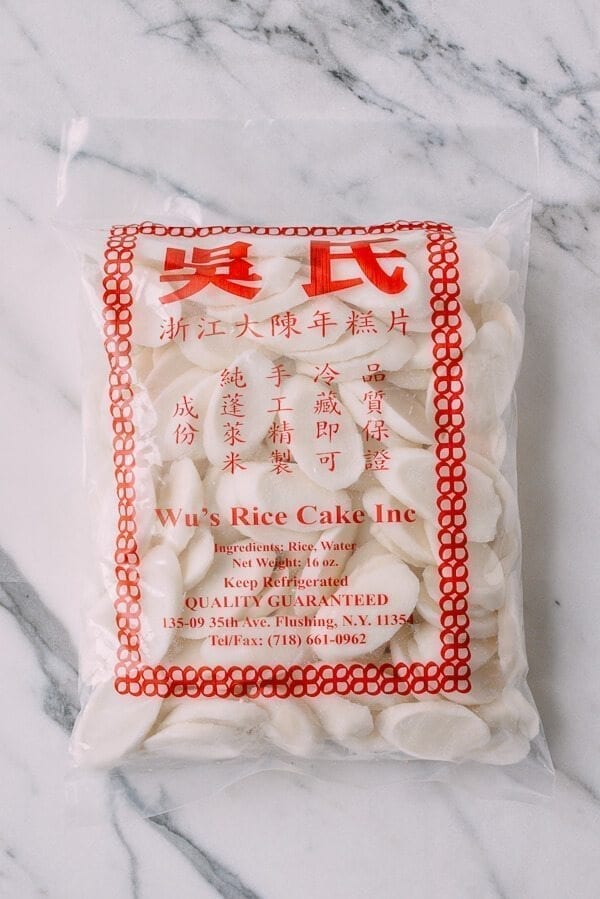
Rice cakes have a chewy consistency that’s kind of like a thick noodle. We think of them almost like Chinese gnocchi, and they’re a family favorite in soups and stir-fries. They come in different shapes (you may be familiar with the Korean rice cakes shaped like small logs), but the small, oval-shaped ones are most common in Chinese cooking. Try them in our recipes for Stir-fried Rice Cakes (Nian Gao), Rice Cake Soup, and Shanghai Rice Cakes with Greens. They’re also great in hot pot or as an addition to other soups. *Gluten-free.*
Wonton Wrappers (Shanghai-Style)
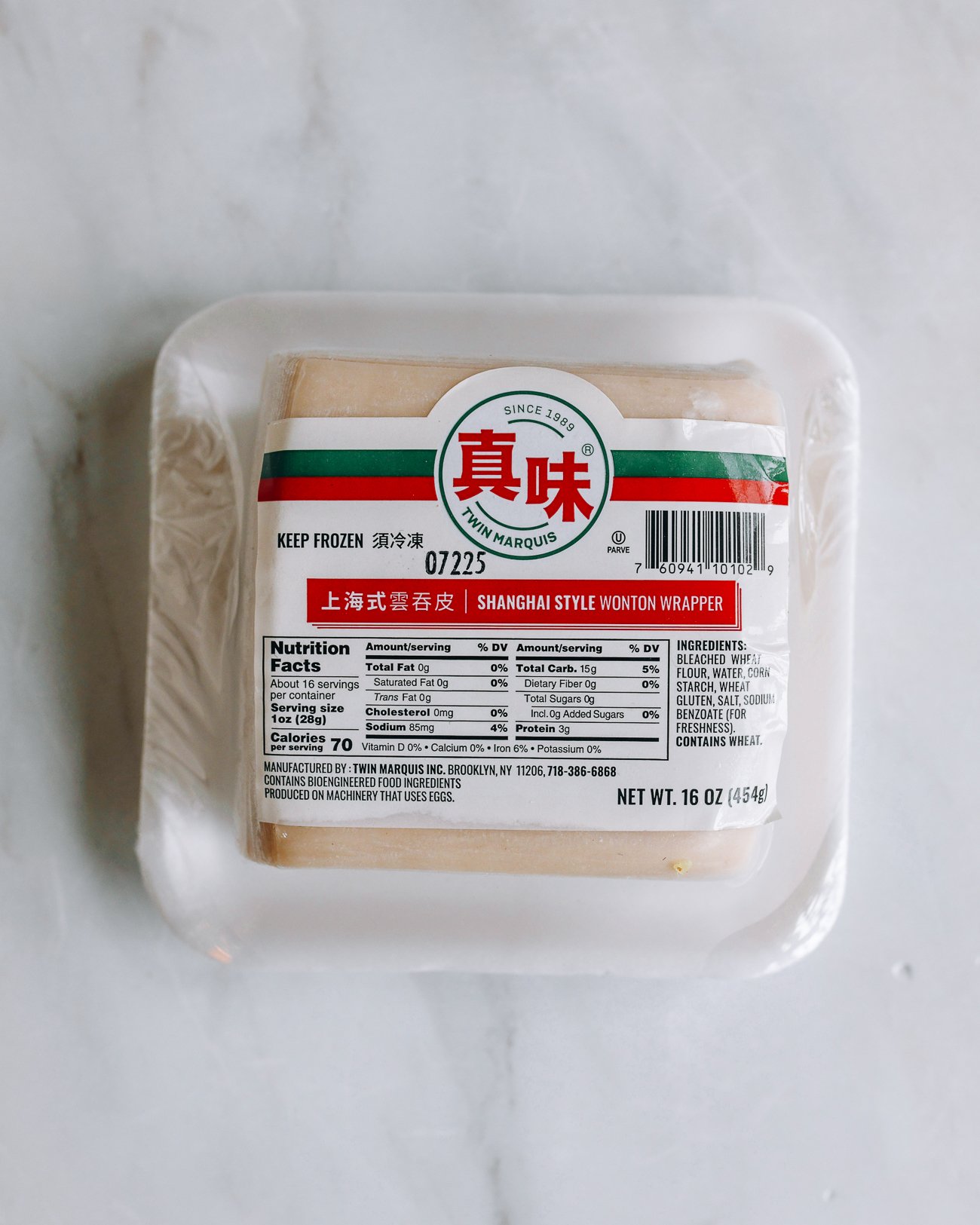
These can be found in the refrigerated section of the Chinese grocery store. You can tell they are wonton wrappers primarily because they are square-shaped. Shanghai-style wonton wrappers are white and somewhat thin. These are the most common type of wonton wrapper we use in our recipes, like San Xian Wontons, Simple Wontons, and Chicken Wontons. They are usually boiled in soup, but you can also use these wrappers for fried wonton recipes like our Cream Cheese Wontons.
Wonton Wrappers (Hong Kong-Style)
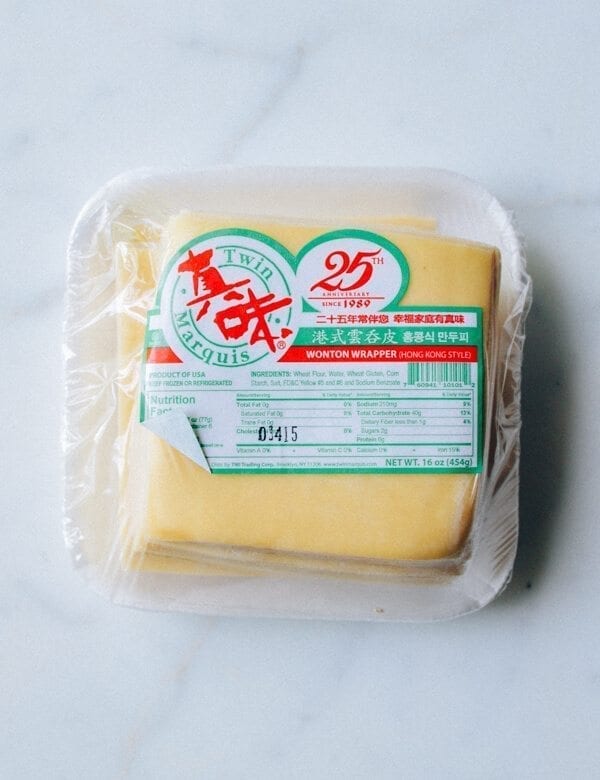
Hong-Kong-style wonton wrappers are also square-shaped, but they’re thinner than the Shanghai-style ones and yellow colored. These are used for Cantonese or Hong-Kong-style wontons, like in our Wonton Noodle Soup recipe. You can also use these wrappers to make Siu Mai (we have a great siu mai recipe in our cookbook!). Just stuff the filling into the wrapper to make an open-topped pocket, and fold down any corners, squeezing them to the sides of the wrapper.
Dumpling Wrappers (Shanghai-Style)
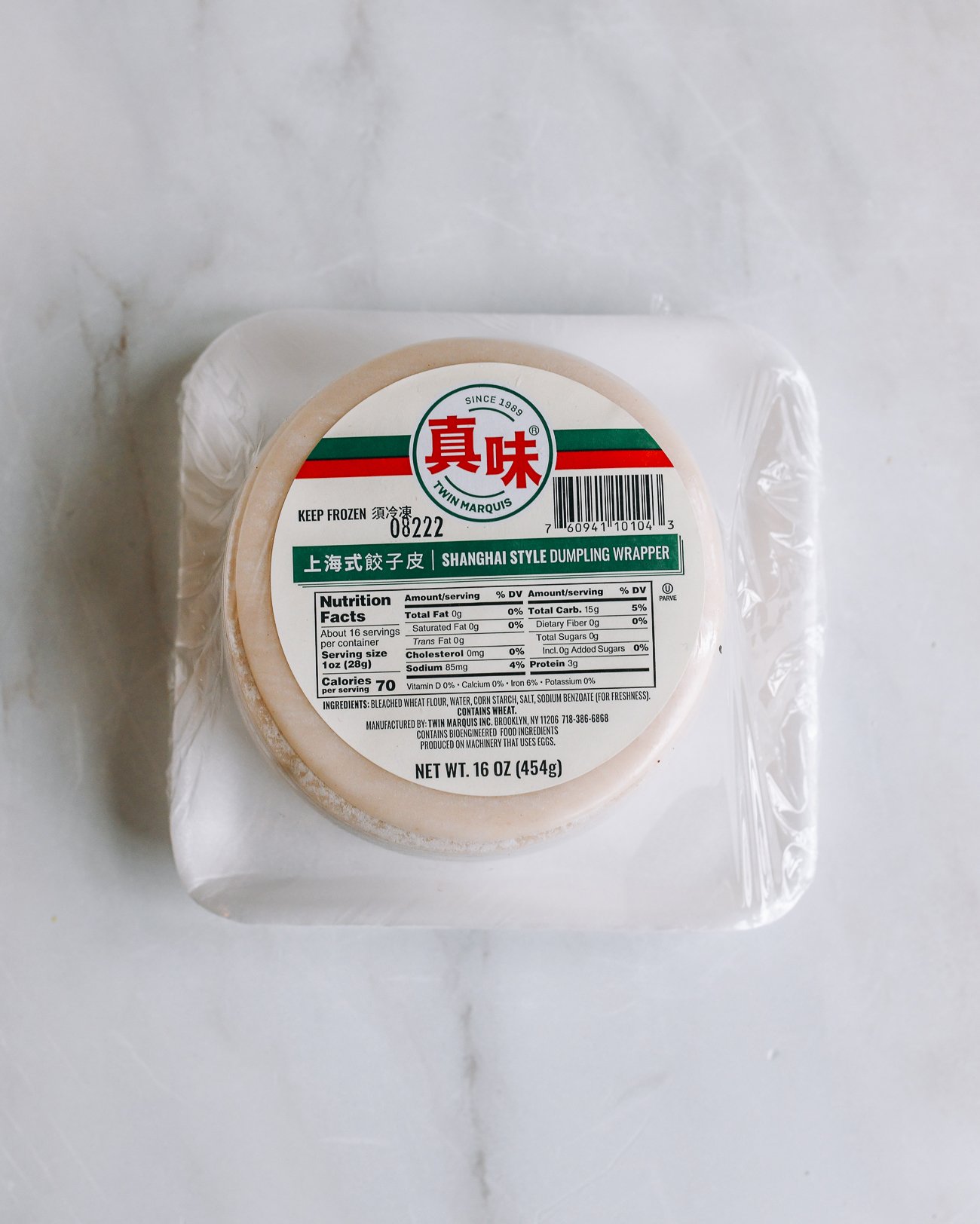
Unlike wonton wrappers, which are square, dumpling wrappers are round. There are many brands and types varying in thickness, but we prefer Shanghai-style dumpling wrappers for most applications. They’re white and on the thinner side (some brands make a thicker Northern-style wrapper). We use these in most of our dumpling recipes, though you can also make your own wrappers with just flour and water. See our homemade dumpling wrapper recipe. Looking for a GF dumpling wrapper? See our Gluten-Free dumpling recipe.
Dumpling Wrappers (Hong Kong-Style)
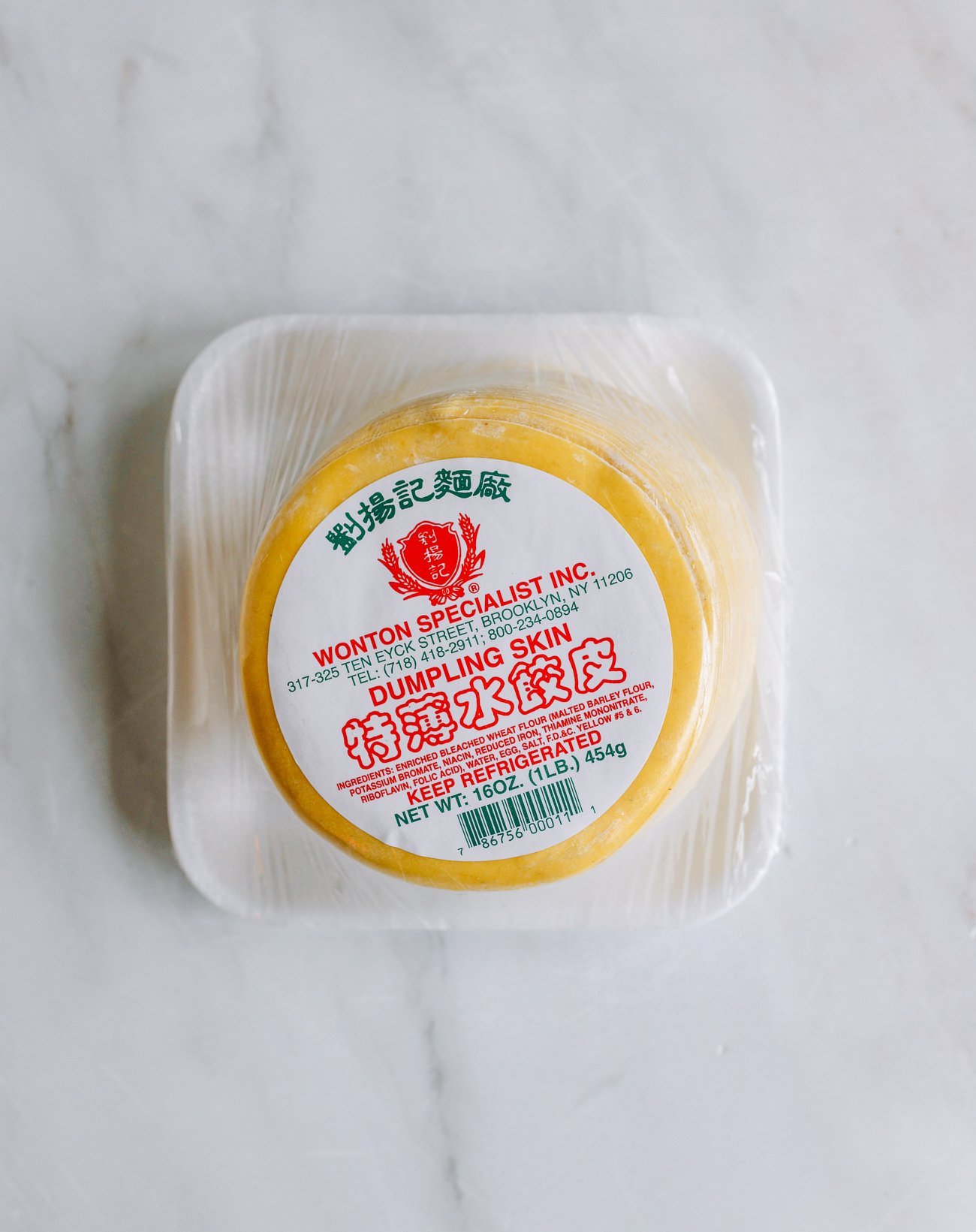
Like Hong-Kong-style wonton wrappers, Hong-Kong-style dumpling wrappers are very thin and yellow in color. We use them primarily to make siu mai (as in the recipe in our cookbook). That said, we have also used them to make gyoza, as well as our Easiest Pork & Cabbage Potsticker recipe. If you find these too thin for the dumplings you’re making, you can double them up to make them thicker. Check out our post on how to fold dumplings.
Chinese Spring Roll Wrappers
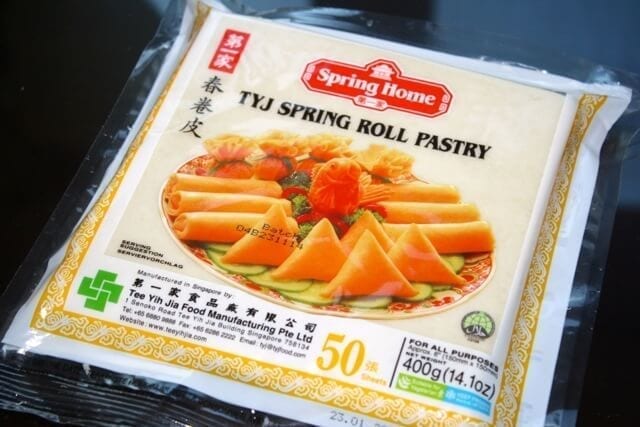
You can find these in the refrigerated or freezer section of the Chinese grocery store. Unlike egg rolls, which are an American thing, spring rolls are actually eaten in China—a specialty at dim sum restaurants and during Chinese New Year. Try our Shanghai-Style Spring Rolls or Cantonese-Style Spring Rolls.
Egg Roll Wrappers
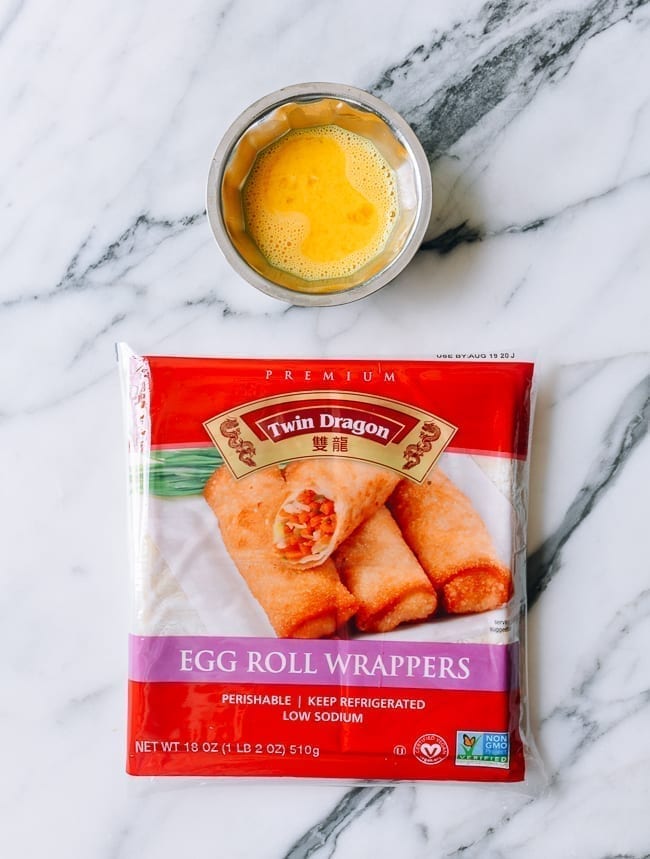
Egg rolls aren’t as popular as they once were, but they’re a classic and in our mind, here to stay! We have several egg roll recipes including our Classic Takeout Egg Roll, Vegetable Egg Rolls, and Chicken Egg Rolls. These wrappers are sold in Asian stores, but we’ve seen them in some supermarkets across the U.S. Find them in refrigerated areas of the store (perhaps near the tofu). They’re much thicker than spring rolls, and rather than a smooth outer appearance after frying, they bubble up for that signature egg roll look!
Vietnamese Rice paper Wrappers
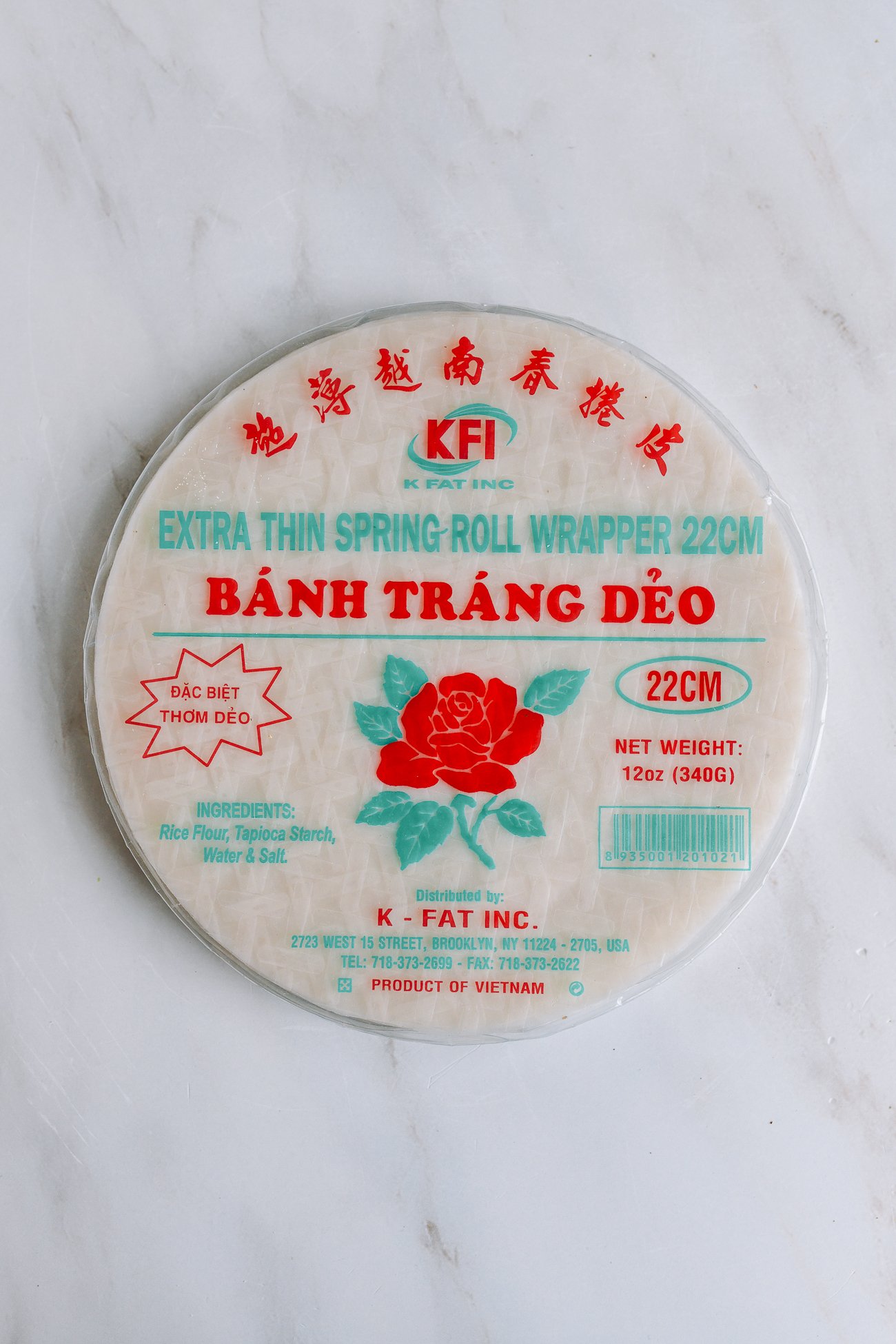
These Vietnamese rice paper wrappers are sold dried, and must be soaked very briefly (just a few seconds) in water in order for them to be pliable enough to wrap around fillings. You can simply soak them and fill them with fresh/cooked ingredients to make summer rolls, or use them to make fried Vietnamese spring rolls, known as Cha Gio. We have recipes for both, so head to the dry goods aisle of your local Chinese or Southeast Asian market, grab a pack of these wrappers, and give one of those recipes a try! *Gluten-free.*
our hand-picked pantry essentials—in one place!
We worked with Pearl River Mart, a family-owned Manhattan Chinatown institution in business since 1971, to collect our hand-picked pantry essentials (and some extras!) into this incredible Pantry Essential Friendship Box. These are the ingredients we use in our own kitchen. Get it shipped directly to you, and start cooking!
Get The Woks of Life x Pearl River Mart Pantry Essentials Friendship Box!
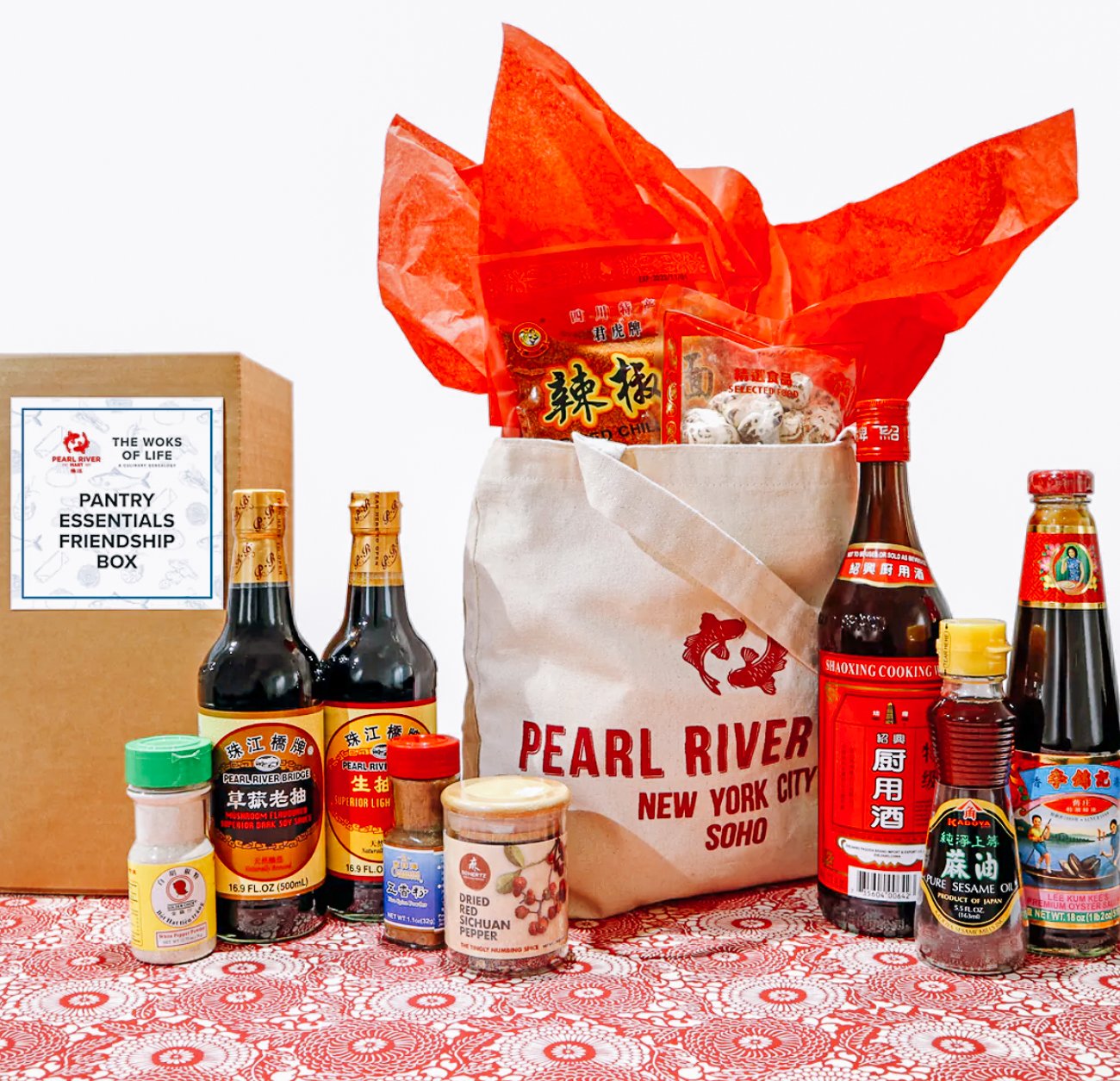
Wrap it up along with a copy of our cookbook for a unique wedding/wedding shower, holiday, birthday, or anytime gift! If you want to beef up the gift basket even more, Pearl River Mart sells woks, wok spatulas, and a plethora of other Chinese kitchen equipment! Check out our Chinese cooking tools page for ideas.